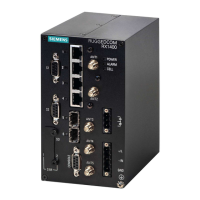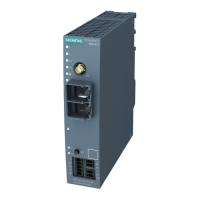Do you have a question about the Siemens RX1400 and is the answer not in the manual?
Explains the Network Configuration Protocol (NETCONF) and its purpose.
Retrieves device state and running configuration data using <get>.
Retrieves candidate or running configuration data using <get-config>.
Directly edits the active configuration, taking effect immediately.
Uses a safe workspace for configuration changes before committing.
Prevents concurrent configuration changes by locking datastores.
Checks configuration syntax before committing.
Applies candidate configuration changes to the running configuration.
Actions related to administrative tasks via NETCONF.
Shuts down the device, allowing a power removal window.
Restarts the device.
Resets the device to factory default settings.
Actions related to network interfaces via NETCONF.
Example of setting the system clock using an action command.
Example of restoring factory default settings.
Modifies system name using candidate config, locking, and committing.
Modifies system name directly in the running configuration.
Example of creating a static VLAN using NETCONF.
Example of assigning a PVID to a port.
Example of disabling Spanning Tree on a specific port.
Example of configuring an IP address on a specific port.
Example of deleting an IP address and its container element.
Example of setting a static route in the configuration.
Example of globally disabling Spanning Tree using nc:operation='delete'.
Example of retrieving all IP addresses from the running configuration.
Example of retrieving active routes from the running configuration.
Example of configuring static multicast routing on a Layer 3 device.
Example of enabling static multicast routing on a Layer 3 device.
Example of retrieving static multicast status.
Example of replacing an existing IP address with a new value.
Example of configuring a port to obtain an IP address via DHCP.
Example of configuring OSPF area and network on a Layer 3 device.
Example of enabling the OSPF passive-default option.
Example of configuring an OSPF port as non-passive.
Example of configuring OSPF parameters.
Example of enabling OSPF redistribute-connected.
Example of enabling OSPF on a Layer 3 device.
Example of retrieving OSPF status information.
Example of configuring the DHCP server service.
Example of configuring the DHCP server's listening port.
Example of enabling the DHCP server service.
Example of disabling an Ethernet port using nc:operation='delete'.
Example of enabling an Ethernet port.
Example of checking an IP address on a specific port.
Example of changing a user's password.
Commits changes to the configuration.
Changes specified data in a configuration.
Locks a configuration, preventing other edits.
Explains the Network Configuration Protocol (NETCONF) and its purpose.
Retrieves device state and running configuration data using <get>.
Retrieves candidate or running configuration data using <get-config>.
Directly edits the active configuration, taking effect immediately.
Uses a safe workspace for configuration changes before committing.
Prevents concurrent configuration changes by locking datastores.
Checks configuration syntax before committing.
Applies candidate configuration changes to the running configuration.
Actions related to administrative tasks via NETCONF.
Shuts down the device, allowing a power removal window.
Restarts the device.
Resets the device to factory default settings.
Actions related to network interfaces via NETCONF.
Example of setting the system clock using an action command.
Example of restoring factory default settings.
Modifies system name using candidate config, locking, and committing.
Modifies system name directly in the running configuration.
Example of creating a static VLAN using NETCONF.
Example of assigning a PVID to a port.
Example of disabling Spanning Tree on a specific port.
Example of configuring an IP address on a specific port.
Example of deleting an IP address and its container element.
Example of setting a static route in the configuration.
Example of globally disabling Spanning Tree using nc:operation='delete'.
Example of retrieving all IP addresses from the running configuration.
Example of retrieving active routes from the running configuration.
Example of configuring static multicast routing on a Layer 3 device.
Example of enabling static multicast routing on a Layer 3 device.
Example of retrieving static multicast status.
Example of replacing an existing IP address with a new value.
Example of configuring a port to obtain an IP address via DHCP.
Example of configuring OSPF area and network on a Layer 3 device.
Example of enabling the OSPF passive-default option.
Example of configuring an OSPF port as non-passive.
Example of configuring OSPF parameters.
Example of enabling OSPF redistribute-connected.
Example of enabling OSPF on a Layer 3 device.
Example of retrieving OSPF status information.
Example of configuring the DHCP server service.
Example of configuring the DHCP server's listening port.
Example of enabling the DHCP server service.
Example of disabling an Ethernet port using nc:operation='delete'.
Example of enabling an Ethernet port.
Example of checking an IP address on a specific port.
Example of changing a user's password.
Commits changes to the configuration.
Changes specified data in a configuration.
Locks a configuration, preventing other edits.
| Brand | Siemens |
|---|---|
| Model | RX1400 |
| Category | Network Router |
| Language | English |











